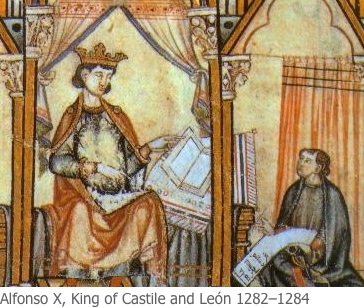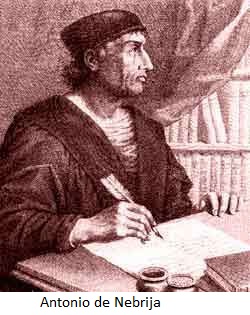1. Introduction
Castilian
Spanish – not any one localized dialect of it, but a supra-regional or
‘neutral’ variety – supplies the model for standard Spanish in Spain (some
Latin Americans also regard Castilian usage as being the most prestigious,
although in practice the majority of Latin American speakers now gravitate towards regional or even national
linguistic norms). The sociolinguistic pre-eminence of Castilian usage stems from the way in which Spain the nation state came into being.
Castile emerged as the driving force behind the Reconquest and was the senior
partner in the 15th century union with Aragon, which effectively resulted in
the formation of modern Spain. It was only to be expected that the speech
patterns that were c haracteristic of Castile would form the basis for any
subsequent standardization of the national language.
haracteristic of Castile would form the basis for any
subsequent standardization of the national language.
Historically
it seems that upper-class Toledo speech provided the basis for the first
standard orthography, which was developed by scribes at the Toldeo royal court during the 13th century
under the auspices of Alfonso X el Sabio.
Over the centuries this spelling system has been progressively modified to
take account of changes in pronunciation, but the focus on Castilian
usage has remained in place. Codification of the grammar crystallized a century and a half later in the publication of Nebrija’s celebrated Gramática de la lengua castellana (1492). This
was distributed widely in Spain and the colonies, thus helping to consolidate the Castilian dialect’s position at
An early example of the emergent standard dialect is given below:
Si el marido quisiere dar algo ala mugier o la mugier al marido non auiendo fijo. puedalo fazer despues que fuere el anno passado desde que cassaren & non ante. (From the Fuero Real, 13th century.)‘If the husband wants to give something to the wife or the wife to the husband, there not being children, they can do it after one year has passed since they married and not before.’
2. Phonetics and phonology
Given the way standard Spanish is defined, features that are general in Castilian usage, particularly in terms of pronunciation, are likely to belong to the standard system enshrined in the normative manuals. Two possible candidates for non-standard but widespread Castilian phonological tendencies are the following:
- the articulation of word-final /d/ as [θ], as in [saluθ] salud ‘health’, [bondaθ] bondad ‘goodness’
- the articulation of /s/ as [ɾ] before a dental consonant, as in [loɾðjentes] los dientes ‘the teeth’ and [loɾθapatos] los zapatos ‘the shoes’.
Almost
uniquely in the Spanish-speaking world, Castilian /s/ is retroflex (phonetic symbol: [ʂ]), with the tip of the tongue curled backwards
to just behind the alveolar ridge. This type of sibilant has a lower pitch than
the blade-alveolar or blade-dental sibilant [s] that is found in the rest of
the Spanish-speaking world. On the other hand, the pitch is not as low as for
palato-alveolar [ʃ], the sound foreign learners of
Spanish often p roduce when attempting a Castilian-style [ʂ]. Among speakers who have emigrated
from Andalusia to Castilian cities (especially Madrid), /s/ pronunciation is
usually the last speech variable to be adjusted in any process of dialect
shift.
roduce when attempting a Castilian-style [ʂ]. Among speakers who have emigrated
from Andalusia to Castilian cities (especially Madrid), /s/ pronunciation is
usually the last speech variable to be adjusted in any process of dialect
shift.
The /ʎ/ ~ /ʝ/ opposition is associated primarily with Castilian Spanish, having been lost in Andalusian Spanish and most Latin American varieties. However even in the Castilian dialect area it is frequently neutralized, with youth and/or southern-ness being the normal correlates of the loss or erosion of the distinction.
The
remaining features that merit comment are fairly localized. With regard to vowels, the most important divergence from standard
Spanish consists in the raising of the mid vowels in unstressed final
syllables, as in [jelu] hielo ‘ice’
and [letʃi] leche ‘milk’. This phenomenon appears to reflect the influence of
Asturian and is associated mainly with western Cantabria.
In terms of consonants, the most significant dialectalism is the so-called r asibilada (‘assibilated r’), which is common in the Spanish of north central and north-western areas of Spain (Alava, La Rioja, Navarre, Aragon). The term r asibilada refers to the occurrence of a voiceless or voiced retroflex sibilant ([ʂ] or [ʐ]) where standard Spanish has [ɾ] or [r]. In assibilating dialects, the word decir ‘to say’, for example, may be indistinguishable from decís ‘you say’, both being pronounced [deθiʂ].
The assibilation of /ɾ/ and /r/ is common also in Latin America and there, as
in northern Spain, the distribution of the voiceless and voiced variants
usually follows a common pattern. The voiceless variant [ʂ] usually appears in syllable-final position or
after a voiceless stop, as in [paʂke] parque ‘park’ and [pʂopjo] propio ‘own’. One common instance of this pattern, viz. [tʂ], may be barely
distinguishable from the affricate [tʃ], with the result that words such
as otro ‘other’ and ocho ‘eight’ may approach homonymy in
assibilating dialects. The voiced variant [ʐ] tends to appear word-initially or
intervocalically (in words spelled with -rr-),
as in [ʐoxo] rojo ‘red’ or [peʐo] perro ‘dog’.
3. Grammar
Surprisingly perhaps,
given the link between Castilian Spanish and Standard Spanish, many speakers in Castile
exhibit leísmo and/or laísmo. The first of these terms refers to the use of le (and less commonly les) in the function of direct object, while the second refers to the use of la and las in the function of indirect
object. According to the ‘standard’ system of object clitics in Spanish, la and las are accusative or direct object pronouns only, while le and les are in principle reserved for the dative or indirect object function. This reflects the fact that la and las, together with lo and los, descend from accusative forms of the Latin personal pronoun, whereas le and les descend from dative forms.
Leísmo is most common when the
reference is to a human being, but it is quite frequent also when the
antecedent is any animate entity. In some parts of Old Castile the phenomenon
is related to the count–mass distinction, with le(s) being used whenever the antecedent is a (masculine) count
noun (i.e. a noun that is used of discrete objects, such as niño ‘child’, árbol ‘tree’, perro ‘dog’, coche ‘car’ etc.). Compare,
for example, (1) and (2) below:
(1) El coche no le mueven de ahí.
‘They don’t move the car from there.’
(2) El café ya no lo pruebo.
‘I no longer drink coffee.’
|
Masculine
|
Feminine
|
||||
Human referent
|
Non-human referent
|
|||||
sing. |
plu. |
sing. |
plu. |
sing. |
plu. |
|
Direct object
|
le |
les
|
lo
|
lo
|
la
|
las
|
Indirect
object
|
lo |
los |
||||
A phenomenon that is characteristic of northern Castile, Cantabria and the Basque Country involves routinely using the conditional form in place of the past subjunctive:
(3) Si haría buen tiempo, iríamos a la ermita.
‘If the weather was good, we would go to the chapel in the country.’(4) Le compré los caramelitos para que se estaría callado.
‘I bought him the sweets so that he would be quiet.’(5) Yo me fui antes de que llegaría.
‘I left before he/she arrived.’(6) Ojalá me tocaría el gordo.
‘If only I won the lottery.’(7) No encontré a ninguno que lo haría.
‘I found no one who would do it.’
With the
possible exception of (7), each of the above sentences would be regarded as
ungrammatical by speakers from outside the far north of Spain.
An
additional feature of northern varieties is a preference for the preterite in
cases where speakers from Madrid, say, or southern Spain would be likely to use
the perfect. Thus, for example, ¿Comiste
ya? ‘Have you eaten yet?’, Eso no lo
oí yo ‘I haven’t heard that’.
4. Lexicon
As is to be expected, there are few lexical items that are general in Castile and yet do not belong to the standard vocabulary. Most studies of the Castilian lexicon have highlighted items whose use is limited to small geographical areas, such as individual provinces. On the other hand, most manuals report the widespread use of caer ‘to fall’ and quedar ‘to remain’ as transitive verbs:
(8) Me cayó el caballo en carnaval.
‘The horse threw me at the carnaval.’(9) Quedé el libro sobre la mesa.
‘I left the book on the table.’
References
Holmquist, Jonathan. 1985. ‘Social Correlates of a Linguistic Variable: a study in a Spanish village.’ Language in Society 14, 2:191–203.